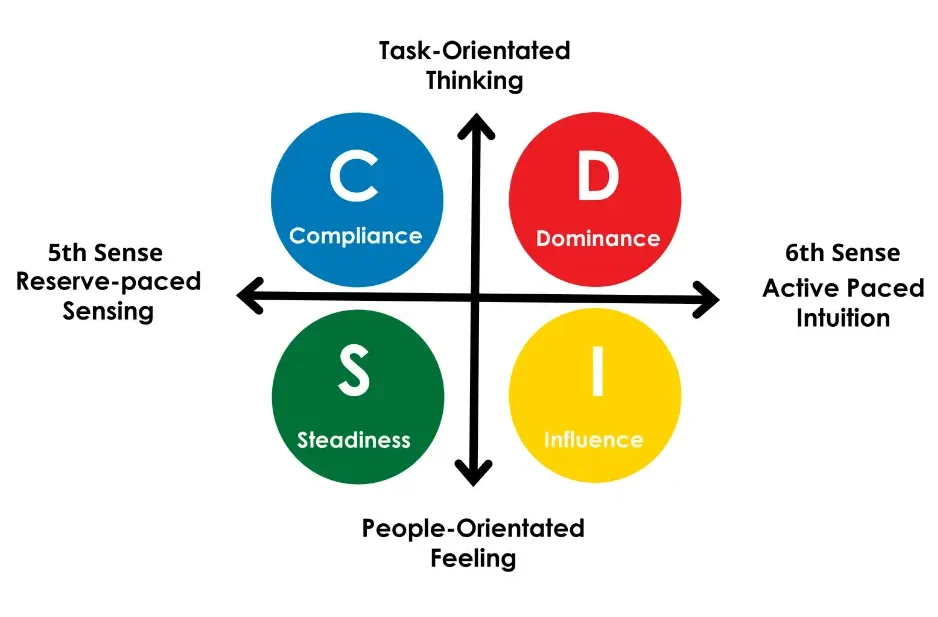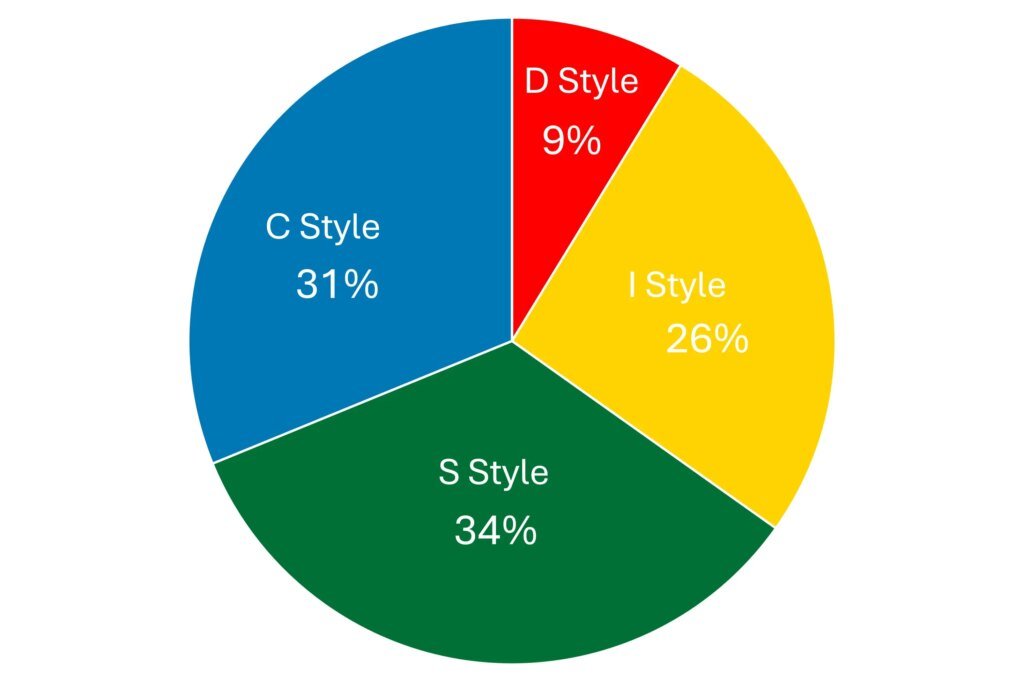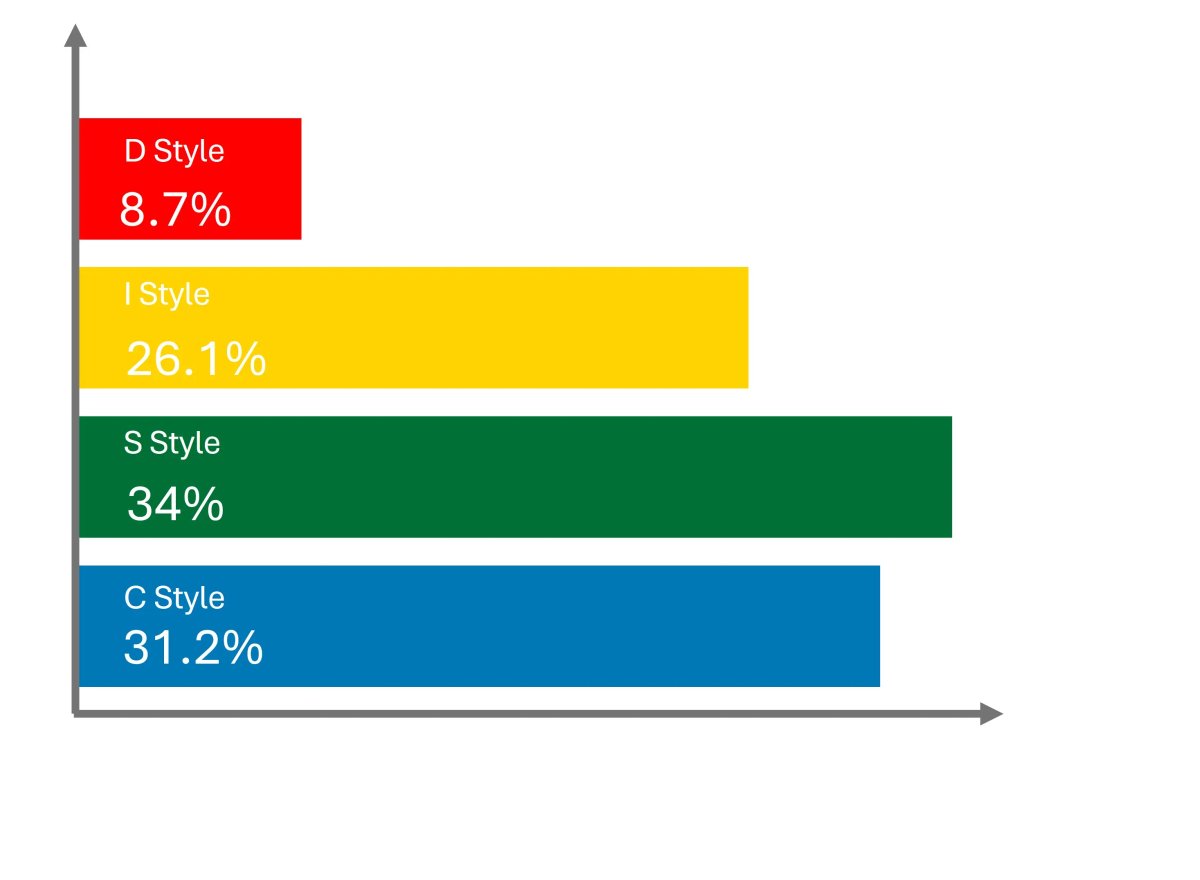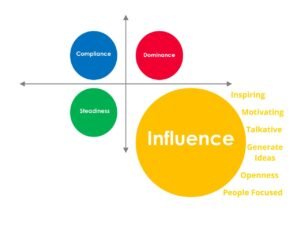What are the four DISC personality types?
The DISC Personality types originate from the work of Carl G Jung and William Moulton Marston, who identified four primary personality types that correspond to different behavioural responses. The main characteristic of each disc profile type is used as a representative word for that type.
The DISC personality profile descriptions are:
When placed on two overlapping axes, the disc personality types form four DISC quadrants.
Four-Quadrant Model
Carl G. Jung proposed four primary functions of consciousness, and each created a behavioural axis.
- Sensing – Intuition
- Thinking – Feeling
Jung’s work formed the basis of the four-quadrant model later developed by Marston. By placing the two axes at right angles, four quadrants form. Each describes a behavioural pattern, which we refer to as the four DISC personality type

How to Determine your DISC personality?
The most reliable way to determine your DISC personality type is to take a questionnaire. The Extended DISC® Assessment takes less than 10 minutes to complete and will produce your report instantly. The assessment plots your location on the DISC quadrant and describes how you may come across to others in the workplace. In comparison to other DISC tools, Extended DISC® reports on 160 different disc assessment types. The disc assessment results are more personalised and unique to who you really are rather than putting you in one of only 4 disc personality types.
With lots of training and practice, you can also learn to speed read others’ DISC personality types, using a simple three-step process, called OAR. OAR is an acronym that represents the three steps, Observe, Assess and Recognise. As you become more accustomed to the DISC Personality Types, you will find it more natural to identify the styles of others. You will think to yourself ‘she’s an I style’ or ‘he’s a C style.’ As with most skills, learning the OAR process takes practice and concentration.
Start Using DISC Assessments Today
What is the Best DISC Personality Type?
It’s tempting to believe that there is one personality type that is better than the rest. However, the truth is that none of the DISC personality types is better or worse than the other. The DISC personality theory does not have any good/bad categories, making it a behavioural inventory, not a test that one can pass or fail.
We can all exhibit behaviours from all four disc quadrants and disc profile types. However, some of these behaviours will come naturally to us with very little concentration or effort required. Whereas, other behaviours will require a lot more energy and focus.
Understanding your DISC personality type will help you recognise which jobs are naturally suited to your style and which roles may require more effort and concentration from you. Knowing your DISC personality will also help your manager to understand your ideal working environment and whether you need lots of instruction or to be left alone to work independently.
The DISC personality types each have their unique strengths and areas in which they naturally excel. They also have development areas, which are areas they need to focus on to achieve. For example, a D style person needs to make a conscious effort to focus on lots of information and details as this is not something that comes naturally to them. As a result, they will consume a large amount of energy adapting to this behaviour.
Your DISC Personality type does not limit you in any way. It merely helps you understand what behaviours will take energy and which come naturally to you.
What DISC Personality Makes the Best Leader?
Wouldn’t it be easy if there was one! We could continuously hire that DISC personality across all organisations, knowing that they would always succeed in their role. Unfortunately, the answer here is no. There is not an ideal DISC leadership personality type that is better than the others.
Leaders come from all four disc quadrants and each leader has their unique disc assessment type, strengths, and development areas. Some areas of leadership will come naturally to them, whereas they will need to apply lots of concentration and effort in other areas.
- D styles are task-orientated leaders. Their authoritative leadership style is based on power, results and distance. They are decisive and tend to make quick decisions. They perform well in a crisis.
- I styles are people-focused and the most social of leaders. Their authority is based on charisma and motivation. As a leader, they tend to create a positive, relaxed and comfortable atmosphere.
- S styles are steady and sincere leaders. They are cool, calm, and collected. The S styles authority is based on experience, expertise and bureaucratic status. They are comfortable in maintaining routines and are generally very service orientated.
- C Styles are slower-paced than other personality types. They are deep thinkers and usually more serious than other DISC personality types. C styles authority is based on rules, standards and quality. They make sure all team members know what is expected of them.
What is the most common DISC personality?
According to the 2024 Extended DISC® validation study, the S personality type is the most common DISC style at a global level. Dominant S styles make up 34% of the worldwide population. In Australia, the most common DISC personality type is also an S style, they contribute to 36.8% of the population.
However, the frequency of DISC styles changes between countries. For example, in Germany, the most common DISC profile is the I personality type, whereas, in Brazil, the most common DISC personality type is the C style.


What is the rarest DISC personality?
The rarest DISC profile is the D style, making up only 8.7% of the global population. This appears to be the trend across all countries, as illustrated in the Extended DISC® 2024 Validation Study.
The exeption is Bulgaria, where the styles are distributed fairly equally, with the 24.% of D styles vs 21.3% S styles.
DISC personality types and careers
Understanding your DISC personality type will help you recognise which careers are naturally suited to your style and which roles may require more effort and concentration from you. Matching your DISC profile type to a career will help you find a work environment that suits you.
Recognising your strengths, challenges and development areas can expand your career opportunities and make you more valuable to your organisation. Receiving your DISC results can help you avoid wasting years in the wrong role or the wrong profession. DISC personality profiles can also help discover engaging career paths you never considered. Understanding your preferred job content and environment can help enhance your job satisfaction and overall well-being.
DISC personality types vs. Myer Briggs
Both DISC and MBTI are profiling tools that provide insight into personality and behaviour. Both tools are respected and used by individuals and organisations globally. However, there are a few notable differences between Extended DISC® and MBTI:
- The Extended DISC® questionnaire is typically 24 questions, taking only 8-10 minutes to complete. Compared to MBTI, which has up to 90 questions and takes significantly longer to answer.
- Extended DISC® analyses a person’s conscious and unconscious behaviour, which allows you to look at who the person really is as opposed to who they think they are. Whereas MBTI focuses only on the conscious style.
- Extended DISC® measures 160 different behavioural styles allowing for much deeper analysis into a person’s true behavioural style. The MBTI tool analyses 16 different styles.
Curious which DISC personality type you are?
Take the Extended DISC® assessment today and discover your natural strengths, ideal work environment, and career opportunities.




